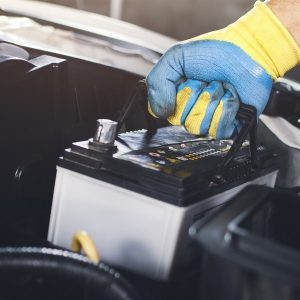What is a deep-cycle battery? This comprehensive guide delves into the concept, types, applications, and maintenance of deep cycle batteries, shedding light on their significance in various industries and addressing common queries surrounding their use.
Part 1. What does deep cycle battery mean?
The term “deep cycle” means the battery can be used for frequent charging and discharging without significant loss.
Deep cycle batteries are rechargeable batteries that provide continuous power to our devices. These batteries usually have thicker plates to withstand deep discharges. Unlike conventional automotive batteries, deep-cycle batteries can provide stable power support for long periods. They are commonly used in devices that require extended power, such as renewable energy systems, boats, RVs, golf carts, and electric vehicles.
Part 2. Types of deep cycle batteries
Flooded Lead Acid Batteries
- These batteries are the traditional and most commonly used type of deep-cycle battery.
- They contain liquid electrolytes and require periodic maintenance to replenish water levels.
- Flooded lead acid batteries are known for their affordability and reliability when adequately maintained.
Absorbent Glass Mat (AGM) Batteries
- AGM batteries use a fiberglass mat to hold the electrolyte solution, making them spill-proof and maintenance-free.
- They are highly resistant to vibration and can be installed in various orientations.
- AGM batteries are popular in applications where maintenance could be more practical and challenging.
Gel Batteries
- Gel batteries utilize a gel-like electrolyte that immobilizes the electrolyte, reducing the risk of spills.
- They are exceptionally durable and perform well in deep discharge cycles.
- Gel batteries are suitable for environments where safety and stability are paramount concerns.
Lithium-ion Batteries
- Lithium-ion deep-cycle batteries offer high energy density and lightweight construction.
- They have a longer lifespan than traditional lead-acid batteries and require minimal maintenance.
- Lithium-ion batteries are gaining popularity in renewable energy systems and electric vehicles due to their superior performance and longevity.
LiFePO4 Batteries
- LiFePO4 batteries, also known as iron lithium batteries, are a type of lithium-ion battery specifically designed for deep-cycle applications.
- They offer excellent thermal stability, safety, and a longer lifespan than other lithium-ion chemistries.
- Due to their robustness and reliability, liFePO4 batteries are widely used in solar energy storage, marine, RV, and off-grid power systems.
Part 3. What is a deep cycle battery used for?
Deep cycle batteries serve various purposes across different industries and applications due to their ability to provide reliable and sustained power over an extended period. Here are some common uses:
Renewable Energy Systems
- Deep cycle batteries are widely used in off-grid and grid-tied solar power systems to store excess energy generated by solar panels.
- They ensure continuous power supply during low sunlight or power outages, enabling homeowners and businesses to reduce their reliance on the grid.
Marine and RV Applications
- Deep cycle batteries power essential onboard electronics, lighting, and appliances in boats, yachts, and recreational vehicles.
- They provide the necessary energy for navigation, communication, refrigeration, and entertainment systems while away from shore power.
Golf Carts and Electric Vehicles
- G golf carts, forklifts, and other electric vehicles use deep-cycle batteries to provide the energy needed for propulsion and accessories.
- They offer long-lasting performance and withstand frequent charge and discharge cycles, making them ideal for transportation applications.
Backup Power Systems
- Deep-cycle batteries are backup power sources for critical infrastructure such as telecommunications towers, medical facilities, and data centers.
- They provide uninterrupted power during blackouts or emergencies, ensuring essential services and operations continuity.
Remote and Off-grid Power Solutions
- Deep cycle batteries are essential components of remote cabins, cabins, and off-grid homes, where access to the utility grid is limited or nonexistent.
- They store energy generated by wind turbines, hydroelectric, or diesel generators, enabling residents to maintain a comfortable lifestyle without relying on external power sources.
Electric Tools and Equipment
- Deep cycle batteries power a variety of electric tools and equipment, including lawnmowers, chainsaws, and power drills, providing portability and convenience for outdoor work.
Part 4. How to charge a deep cycle battery?
Here’s a step-by-step guide on how to charge a deep-cycle battery:
Choose the Right Charger
Use a charger specifically designed for deep-cycle batteries. Avoid using automotive chargers, which may not provide the appropriate charging profile for deep-cycle batteries.
Ensure Proper Ventilation
Charge the battery in a well-ventilated area to dissipate any gases produced during the charging process.
Check Battery Voltage
Before charging, verify the battery’s voltage using a multimeter. A fully charged deep-cycle battery typically reads around 12.6 to 12.8 volts.
Connect the Charger
Connect the charger’s positive (+) to the battery’s positive terminal and the negative (-) to the negative terminal. Ensure proper polarity to avoid damaging the battery.
Set Charging Parameters
Adjust the charger settings according to the battery manufacturer’s recommendations. Deep cycle batteries typically require a multi-stage charging profile, including bulk, absorption, and float.
Initiate Charging
Start the charging process by turning on the charger. Monitor the charging progress and voltage levels regularly to ensure proper charging.
Monitor Temperature
Check the battery temperature periodically during charging. Excessive heat can indicate overcharging or a faulty charger and may damage the battery.
Perform equalization (if needed)
Deep-cycle batteries may require occasional equalization to balance cell voltages and prevent stratification. Follow the battery manufacturer’s guidelines for equalization procedures.
Disconnect Charger
Once the battery reaches full charge, disconnect the charger to prevent overcharging. Most modern chargers have automatic shut-off features to prevent overcharging.
Perform Regular Maintenance
After charging, inspect the battery terminals for corrosion and clean them if necessary. Check the electrolyte levels in flooded lead-acid batteries and top up with distilled water as needed.
Part 5. How long do deep-cycle batteries last?
The lifespan of deep-cycle batteries varies depending on several factors, including the type of battery, usage patterns, maintenance, and environmental conditions. Here’s a breakdown of how long different types of deep-cycle batteries typically last:
Flooded Lead Acid Batteries
- Flood lead-acid batteries can last 3 to 8 years with proper care and maintenance.
- Regular maintenance, which includes checking electrolyte levels and ensuring proper charging, can help extend the lifespan of deep-cycle batteries.
Absorbent Glass Mat (AGM) Batteries
- AGM batteries generally have a longer lifespan than flooded lead acid batteries, lasting between 4 and 10 years.
- Their sealed construction and maintenance-free design contribute to their durability.
Gel Batteries
- Gel batteries typically have a lifespan similar to AGM batteries, lasting between 4 to 10 years.
- Their gel electrolyte composition enhances durability and resistance to deep discharges.
Lithium-ion Batteries
- Lithium-ion deep-cycle batteries have the most extended lifespan among deep-cycle batteries, lasting 8 to 15 years or more.
- Their advanced chemistry and robust construction contribute to their extended lifespan.
- However, lithium-ion batteries are more expensive upfront but can offer better long-term value due to their longevity.
LiFePO4 Batteries
- LiFePO4 batteries are a type of lithium-ion battery specifically designed for deep-cycle applications.
- They typically have a lifespan of 10 to 15 years, making them one of the longest-lasting deep-cycle battery options available.
- Proper maintenance and charging practices are crucial for maximizing their lifespan.
Part 6. FAQs
-
Can you use a deep-cycle battery in a car?
Yes, you can use a deep-cycle battery in a car. Still, it’s not recommended for regular automotive use because deep-cycle batteries are designed for long, slow discharges rather than the short, high-current discharges typical in starting a car engine. -
How do you charge a deep-cycle marine battery?
Connect a deep-cycle marine battery to a compatible battery charger and follow the manufacturer’s instructions. Ensure the charger is suitable for deep cycle batteries and set it to the appropriate voltage and charging mode. -
How do you tell if a deep-cycle battery is bad?
You can tell if a deep cycle battery is terrible by checking its voltage with a multimeter, performing a visual inspection for signs of damage or corrosion, and conducting a load test to assess its capacity to hold a charge under load. -
How do you load test a deep cycle battery?
To test a deep cycle battery, connect it to a load tester and apply a constant load for a specified period while monitoring the voltage. A healthy battery should maintain its voltage within an acceptable range during the test. -
How long will a deep-cycle battery last with an inverter?
The lifespan of a deep cycle battery used with an inverter depends on factors such as the battery’s capacity, depth of discharge, charging regimen, and environmental conditions. Generally, a well-maintained deep-cycle battery can last several years when used with an inverter.
Related Tags:
More Articles

How to Choose the Right Electric Fence Battery?
Choosing the right electric fence battery is key to security. This guide helps you pick a reliable farm, garden, or animal power source.
What Are Lithium Pouch Cells?
Explore how lithium pouch cells work, their structure, advantages, and uses. Learn from a trusted supplier like Ufine Battery for custom lithium solutions.
The Evolution of Ring Battery Pack Technology in Lithium Battery Manufacturing
Ring battery packs are reshaping lithium battery tech. Discover their evolution, key uses, and why they matter for the future of energy storage.
Lithium vs Lithium Salt: What’s the Difference?
Lithium is a pure metal, while lithium salts are stable battery compounds. Learn their key roles and differences in battery manufacturing.
What You Need to Know About AA 3.6V Lithium Battery
Learn all about AA 3.6V lithium batteries—voltage, size, capacity, uses, and the best replacements. Discover why they’re powerful, and highly reliable.




